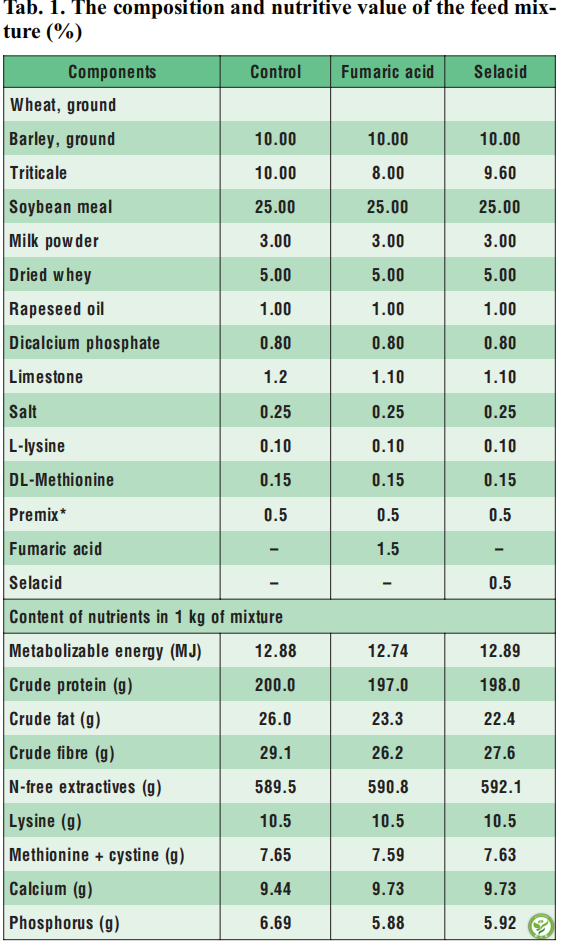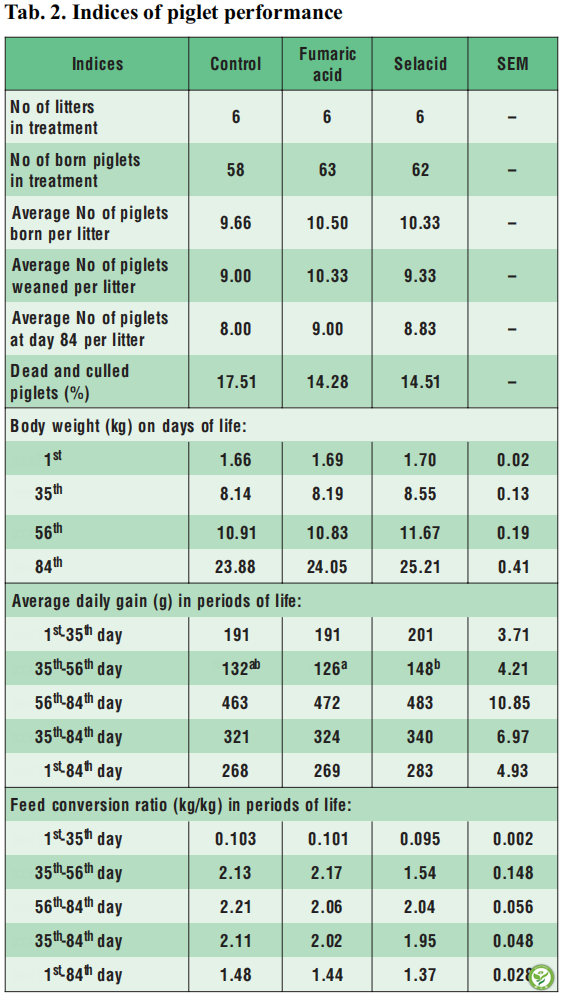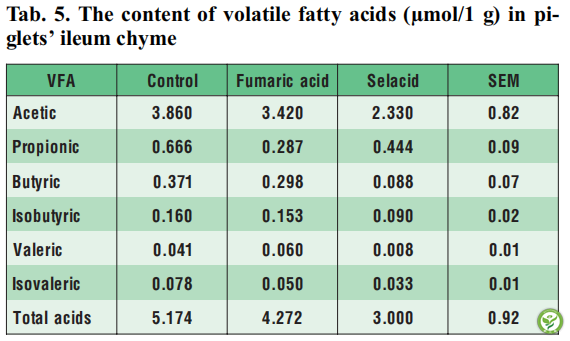Medium-chain fatty acids as feed supplements for weaned piglets
作者:EWA HANCZAKOWSKA, MALGORZATA SWIATKIEWICZ,PIOTR HANCZAKOWSKI, ANDRZEJ WROBEL*
来源:Department of Animal Nutrition and Feed Science, National Research Institute of Animal Production,ul. Krakowska 1, 32-083 Balice
翻译:肠动力研究院 梁琦
【摘要】该实验的目的是检评估中链和短链脂肪酸对仔猪健康、增重,肠道微生物菌群的变化和肠壁形态的影响。检测食糜中需氧菌,厌氧菌、酵母菌和霉菌的数量,酸度和挥发性脂肪酸的含量。将这些酸的效果与传统酸化剂(富马酸)的效果进行比较。实验中183只小猪被分成3个实验组,每组6窝。第一组(对照)喂食没有添加任何酸的标准日粮,第二组饲喂含有1.5%富马酸的相同日粮,第三组喂食含有0.5%中短链脂肪酸的日粮。试验在第84天结束。
在与对照组相比时,含中短链脂肪酸组提高了小猪的增重(分别为283g和268g),但结果差异性并不显著。喂食富马酸组的仔猪体增重(269克)与对照组相比没有差异(268克)。中短链脂肪酸组表现出一定的抗菌作用:仔猪小肠食糜中梭菌的数量降低了33%。富马酸则能显著降低大肠杆菌的量。这些酸对酵母菌和霉菌种群没有影响。
饲食富马酸的仔猪比喂食中短链脂肪酸组和对照组的仔猪具有更高的肠绒毛(分别为302, 257 and 233 µm),但对增重没有影响。各组中挥发性脂肪酸的含量和肠道食糜的酸度也基本相似。
研究结果表明:中链脂肪酸可以改善仔猪的健康和生产性能,不过这种改善与本次研究范围内的微生物菌群或肠粘膜结构的变化无关。
关键词:中链脂肪酸,仔猪生产性能,肠道形态,肠道微生物菌群
以下是实验中的相关图表
表1:饲料的组成和营养数值(%)

说明:预混料组成:维生素:A—2 700 000 IU,D3—400 000 IU;E—8g;K3—0.5g;B1—0.5g;B2—0.8g;B6—0.8g;B12—0.008g;泛酸—2.8g;氯化胆碱—70g;叶酸—0.2g;烟酸—5.0g;镁—10g;锰—12g;碘—0.1g;锌—30g;铁—20g;铜—32g;钴—0.06g;硒—0.04g;完整的石灰石—1000g
表2:仔猪生产性能的指标

说明:a,b—意味着在同一行的不同字母的数值差异显著(P ≤0.05)
表3:小肠食糜中的微生物(Log10 CFU/1 g)

说明:a,b—意味着在同一行的不同字母的数值差异显著(P ≤0.05)
表4:小肠上皮的形态特征

表5:仔猪回肠食糜中挥发性脂肪酸的含量(µmol/1 g)

表6:食糜在胃和小肠不同部位的酸度

概括本实验的研究结果,可以说Selacid饲料制剂中含有的中链脂肪酸可以改善仔猪健康和生产性能。
Summary
The aim of this experiment was to examine the effect of medium- and short-chain fatty acids (Selacid preparation) on piglets’ health, body weight gains, changes in intestinal microflora and intestinal wall morphology. The amount of aerobic and anaerobic bacteria, yeasts and moulds, the acidity and the content of volatile fatty acids (VFA) of digesta were estimated. The effect of these acids was compared with the effect of the traditional acidifier i.e. fumaric acid. The experiment involved 183 piglets allocated to 3 experimental groups, 6 litters in each. Group I (control) was fed with the standard mixture with no supplement. Group II received the same mixture supplemented with 1.5% of fumaric acid and group III received feed mixture supplemented with 0.5% of the Selacid preparation. Experiment was completed at the 84th day of the piglets’ life.
Selacid improved the piglets’ body weight gains when compared to the control group (283 and 268 g, respectively) but this difference was not significant. Body weight gains of piglets receiving fumaric acid (269 g) did not differ from the control ones (268 g) . Selacid had a moderate antibacterial effect: it lowered the number of Clostridium in small intestine digesta by 33%. Fumaric acid significantly lowered the amount of Escherichia coli. Acids had no effect on yeast and mould population.
Piglets receiving fumaric acid had higher intestinal villi than those receiving Selacid and the control ones (302, 257 and 233 µm, respectively) but that had no effect on their body weight gains. The content of volatile fatty acids and the acidity of intestinal digesta were also similar in all groups.
It is concluded that medium- chain fatty acid contained in the Selacid preparation can improve piglets’ health and performance though this improvement is not related to changes in microflora or the structure of intestine mucosa in the scope of this research.
Keywords: medium-chain fatty acids, piglets’ performance, intestinal morphology, intestinal microflora
To recapitulate the results of the present experiment, it can be stated that medium-chain fatty acids contained in the Selacid feed preparation can improve piglets’ health and performance.
如您需原文,请联系本文作者和出版方,或请垂询肠动力研究院。本网站发布的所有资料将尽最大可能注明出处、作者及日期,如无意中侵犯了您的知识产权,请来信及时告知,我们将立即予以删除。
All information released by the WeChat Official Account will do its best to indicate the source, author and date. If we inadvertently infringe on your intellectual property, please inform us in time and we will delete it immediately.





